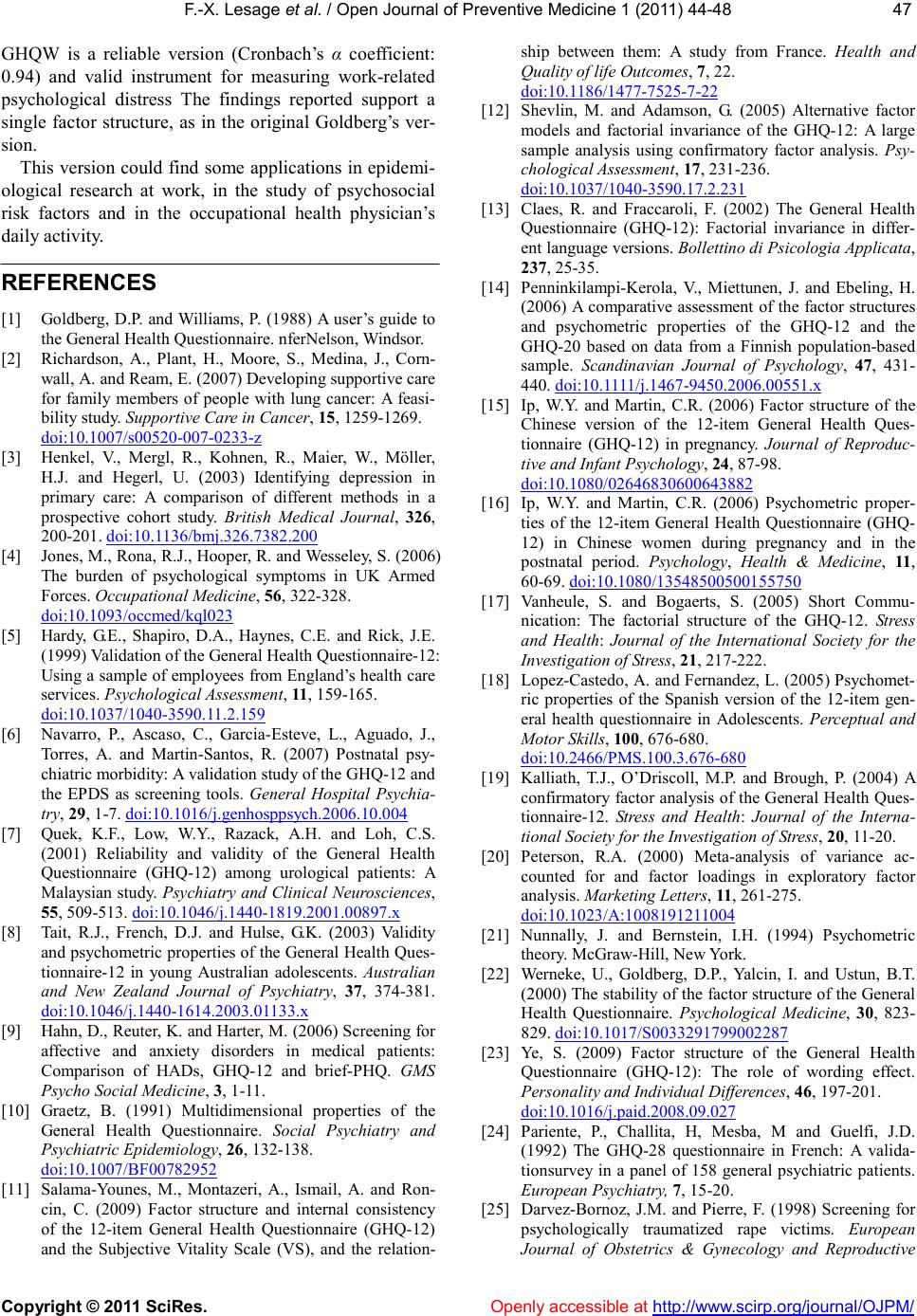
F.-X. Lesage et al. / Open Journal of Preventive Medicine 1 (2011) 44-48
Copyright © 2011 SciRes. Openly accessible at http://www.scirp.org/journal/OJPM/
47
47
GHQW is a reliable version (Cronbach’s α coefficient:
0.94) and valid instrument for measuring work-related
psychological distress The findings reported support a
single factor structure, as in the original Goldberg’s ver-
sion.
This version could find so me applicatio ns in epidemi-
ological research at work, in the study of psychosocial
risk factors and in the occupational health physician’s
daily activity.
REFERENCES
[1] Goldberg, D.P. and Williams, P. (1988) A user ’s guide to
the General Health Questionnaire. nferNelson, Windsor.
[2] Richardson, A., Plant, H., Moore, S., Medina, J., Corn-
wall, A. and Ream, E. (2007) Developing supportive care
for family members of people with lung cancer: A feasi-
bility study. Supportive Care in Cancer, 15, 1259 -12 6 9 .
doi:10.1007/s00520-007-0233-z
[3] Henkel, V., Mergl, R., Kohnen, R., Maier, W., Möller,
H.J. and Hegerl, U. (2003) Identifying depression in
primary care: A comparison of different methods in a
prospective cohort study. British Medical Journal, 326,
200-201. doi:10.1136/bmj.326.7382.200
[4] Jones, M., Rona, R.J., Hooper, R. and Wesseley, S. (2006)
The burden of psychological symptoms in UK Armed
Forces. Occupational Medicine, 56, 322-328.
doi:10.1093/occmed/kql023
[5] Hardy, G.E., Shapiro, D.A., Haynes, C.E. and Rick, J.E.
(1999) Validation of the General Health Questionnaire-12:
Using a sample o f emplo yees from England’s health care
services. Psychological Assessment, 11, 159-165.
doi:10.1037/1040-3590.11.2.159
[6] Navarro, P., Ascaso, C., Garcia-Esteve, L., Aguado, J.,
Torres, A. and Martin-Santos, R. (2007) Postnatal psy-
chiatric morbidity: A validation study of the GHQ-12 and
the EPDS as screening tools. General Hospital Psychia-
try, 29, 1-7. doi:10.1016/j.genhosppsych.2006.10.004
[7] Quek, K.F., Low, W.Y., Razack, A.H. and Loh, C.S.
(2001) Reliability and validity of the General Health
Questionnaire (GHQ-12) among urological patients: A
Malaysian study. Psychiatry and Clinical Neurosciences,
55, 509-5 1 3. doi:10.1046/j.1440-1819.2001.00897.x
[8] Tait, R.J., French, D.J. and Hulse, G.K. (2003) Validity
and psychometric properties of the General Health Ques-
tionnaire-12 in young Australian adolescents. Australian
and New Zealand Journal of Psychiatry, 37, 374-381.
doi:10.1046/j.1440-1614.2003.01133.x
[9] Hahn, D., Reuter, K. and Harter, M. (2006) Screening for
affective and anxiety disorders in medical patients:
Comparison of HADs, GHQ-12 and brief-PHQ. GMS
Psycho Social Medicine, 3, 1-11.
[10] Graetz, B. (1991) Multidimensional properties of the
General Health Questionnaire. Social Psychiatry and
Psychiatric Epidemiology, 26, 1 32-138.
doi:10.1007/BF00782952
[11] Salama-Younes, M., Montazeri, A., Ismail, A. and Ron-
cin, C. (2009) Factor structure and internal consistency
of the 12-item General Health Questionnaire (GHQ-12)
and the Subjective Vitality Scale (VS), and the relation-
ship between them: A study from France. Health and
Quality of life Outcomes, 7, 22.
doi:10.1186/1477-7525-7-22
[12] Shevlin, M. and Adamson, G. (2005) Alternative factor
models and factorial invariance of the GHQ-12: A large
sample analysis using confirmatory factor analysis. Psy-
chological Assessment, 17, 231- 236.
doi:10.1037/1040-3590.17.2.231
[13] Claes, R. and Fraccaroli, F. (2002) The General Health
Questionnaire (GHQ-12): Factorial invariance in differ-
ent language versions. Bollettino di Psicologia Applicata,
237, 25-35.
[14] Penninkilampi-Kerola, V., Miettunen, J. and Ebeling, H.
(2006 ) A comparative assess ment o f the factor structures
and psychometric properties of the GHQ-12 and the
GHQ-20 based on data from a Finnish population-based
sample. Scandinavian Journal of Psychology, 47, 431-
440. doi:10.1111/j.1467-9450.2006.00551.x
[15] Ip, W.Y. and Martin, C.R. (2006) Factor structure of the
Chinese version of the 12-item General Health Ques-
tionnaire (GHQ-12) in pregnancy. Journal of Reproduc-
tive and Infant Psychology, 24, 8 7-98 .
doi:10.1080/02646830600643882
[16] Ip, W.Y. and Martin, C.R. (2006) Psychometric proper-
ties of the 12-item General Health Questionnaire (GHQ-
12) in Chinese women during pregnancy and in the
postnatal period. Psychology, Health & Medicine, 11 ,
60-69. doi:10.1080/13548500500155750
[17] Vanheule, S. and Bogaerts, S. (2005) Short Commu-
nication: The factorial structure of the GHQ-12. Stress
and Health: Journal of the International Society for the
Investigation of Stress, 21, 217-222.
[18] Lopez-Castedo, A. and Fernandez, L. (2005) Psychomet-
ric properties of the Spanish version of the 12-item gen-
eral health questionnaire in Adolescents. Perceptual and
Motor Skills, 100, 676-680.
doi:10.2466/PMS.100.3.676-680
[19] Kalliath, T.J., O’Driscoll, M.P. and Brough, P. (2004) A
confirmatory factor analysis of the General Health Ques-
tionnaire-12. Stress and Health: Journal of the Interna-
tional Society for the Investigation of Stress, 20, 11-20.
[20] Peterson, R.A. (2000) Meta-analysis of variance ac-
counted for and factor loadings in exploratory factor
analysis. Marketing Letters, 11, 2 61-2 75.
doi:10.1023/A:1008191211004
[21] Nunnally, J. and Bernstein, I.H. (1994) Psychometric
theory. McGraw-Hill, New York.
[22] Werneke, U., Goldberg, D.P., Yalcin, I. and Ustun, B.T.
(2000 ) The stab ility of the factor structure of the General
Health Questionnaire. Psychological Medicine, 30, 823-
829. doi:10.1017/S0033291799002287
[23] Ye, S. (2009) Factor structure of the General Health
Questionnaire (GHQ-12): The role of wording effect.
Personality and Individual Differences, 46, 197- 2 01 .
doi:10.1016/j.paid.2008.09.027
[24] Pariente, P., Challita, H, Mesba, M and Guelfi, J.D.
(1992) The GHQ-28 questionnaire in French: A valida-
tionsurvey in a panel of 158 general psychiatric patients.
European Psychiatry, 7, 15-20.
[25] Darvez-Bornoz, J.M. and Pierre, F. (1998) Screening for
psychologically traumatized rape victims. European
Journal of Obstetrics & Gynecology and Reproductive